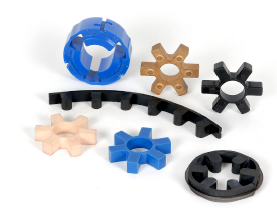Elastomers In Compression
We presents 4 types of elastomer designs to allow for additional versatility in addressing unique application necessities. 1 piece designs are used in the “L” and “AL” designs (referred to as spiders) and multiple component “load cushions” are used in the “C” and “H” model couplings. The load cushions are in sets of six to 14 pieces based on coupling dimension.
Sound Center Spider
The strong center design and style is normally utilized design and style when shafts from the driver and driven tools can be stored separate by a standard gap
Open Center Spider
The open center style allows for your shafts of  the driver and driven for being positioned within a brief distance
the driver and driven for being positioned within a brief distance
Open center spiders offer you shaft positioning versatility but possess a lower RPM capacity
Cushions
Employed solely to the C and H Type couplings
Load cushions are held in place radially by a steel collar that’s connected to among the hubs
Snap Wrap Flexible Spider
Layout will allow for uncomplicated removal from the spider with out moving the hubs
Enables for close shaft separation all the way up to the hubs optimum bore
Highest RPM is 1,750 RPM with the retaining ring, but if utilized using the LC Type (with collar) the standard RPM rating of the coupling applies
Type is obtainable in NBR and Urethane only, and in restricted sizes
Spider Materials
SOX (NBR) Rubber
The common material that’s very versatile material that’s oil resistant
Resembles natural rubber in resilience and elasticity, and operates effectively in temperature ranges of -40° to 212° F (-40° to 100° C)
Urethane
Has one.five instances higher torque capability than NBR
Very good resistance to oil and chemical compounds
Material supplies less dampening effect and operates at a temperature range of -30° to 160° F
Hytrel
Versatile elastomer created for substantial torque and large temperature operations
Operates in temperatures of -60° to 250° F (-51° to 121° C)
Bronze
Rigid, porous, oil-impregnated metal insert solely for very low velocity (max 250 RPM) applications requiring high torque capabilities
Not affected by water, oil, filth, or excessive temperatures – operates in temperatures of -40° to 450° F (-40° to 232° C)
